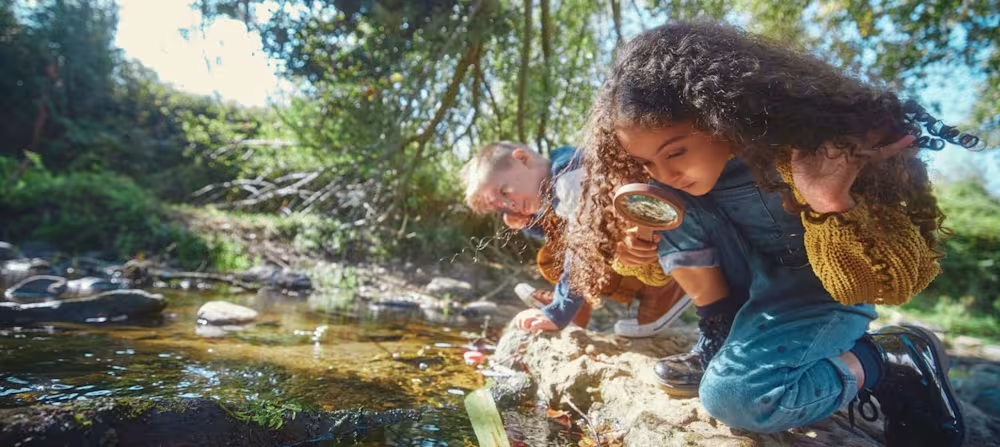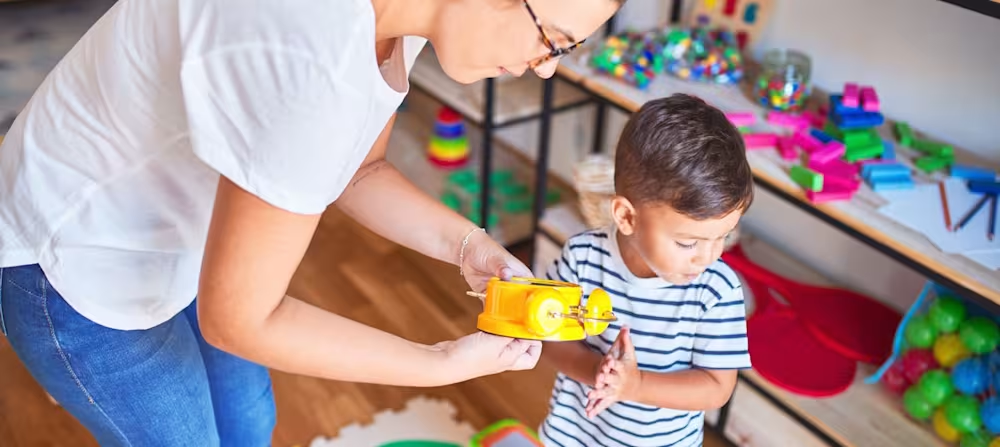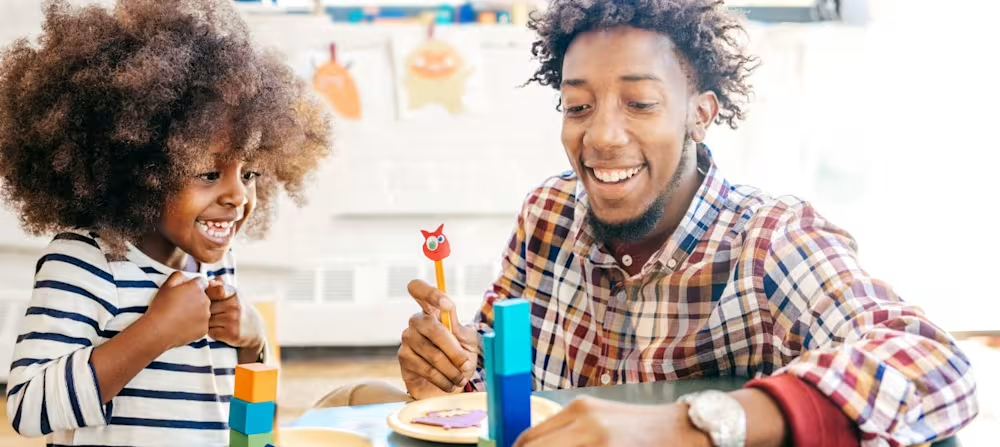Art activities for kids: Using creativity to express emotions
Updated Oct 17, 2025

Babies and children experience a full range of emotions, just like us – some enjoyable, and some very big and uncomfortable. Unlike adults, kids don’t always have the ability to express their emotions with words. Well, adults don’t always have this capacity either! Fortunately, we can use art to express our emotions.
Art activities can serve as a powerful outlet for emotions. Children can express how they feel and think through their art, which gives them a way to express thoughts and feelings that they don’t have the words to talk about. When children transform internal emotion into an external work of art and expression, it helps them see the emotion as being separate. They aren’t their anger or their fear. Art helps children cope with the natural stresses of growing up.
Research shows that art activities develop the brain in various ways. A National Endowment for the Arts literature review [] demonstrated that arts participation during early childhood has benefits for social-emotional development, including emotion regulation and social skills. You don’t have to be an artist for you and your child to benefit from art and emotional well-being.
Choosing the right art activities for your kid
Katharine Phleglar, Art Therapist and Executive Director of Arts for Life, explained that children of different ages can use the same art materials in different, ways. Younger toddlers may take a crayon, hold it upside down, and scribble it across a sheet of paper. Older toddlers and preschoolers may use that same crayon and paper, but work toward more specific shapes. Older children may create an elaborate picture, likely holding the crayon with the tip down. Side note about crayons: fight the urge to have your kiddo hold the crayon or other material the “right” way. In art as expression, there is no correct way to do anything! Be open, and playful, and just enjoy the experience of creation.
Phelglar explains that “a tiny human can use art materials as soon as they can hold something and engage. You can make something meaningful with an 18 month old. And you’re practicing frustration tolerance when the marker goes on the knee instead of the paper.” Art at these early ages is all about exploring, playing, learning, and expressing oneself.
Art activities for toddlers
Even babies can enjoy artistic creation, and delight in the sensory experience it provides.
Here are a few simple art activities to try with your toddler:
Finger painting – or heck, foot or whole body painting! All you need is nontoxic, washable paint and either paper or a safe surface onto which they can paint.
Clay on paper. Toddlers can manipulate and play with the playdough or clay any way they’d like. One fun activity is to pull pieces of clay and press them into the paper. They can press the clay with their hands, stomp it with their feet, or use spoons, wooden blocks, or big carrots or celery stalks to press it into the paper or make impressions in the clay.
Vegetable painting. Use potatoes, pepper cucumber slices, or any other veggie you have on hand as a painting tool. Painting with sponges can be fun too.
Drawing (well, scribbling) with nontoxic crayons, markers, or chalk.
Making impressions or drawing in sand.
Art activities for preschoolers and school-aged children
Everything listed for toddlers, plus:
Watercolor painting or ice painting. Add water and 5 - 10 drops of food coloring into each of the ice cube tray sections and carefully stir. You can use toothpicks or small sticks to stir in the food coloring and serve as a handle. Or, if you have popsicle molds on hand, that works great too! Freeze the colored water overnight and voila! Time for a masterpiece and loads of sensory exploration in the process.
Molding/sculpting clay allows toddlers to create, while also getting out frustration and big feelings through the molding, pounding, and manipulating the clay.
Torn paper and mess up art. Take anything that’s torn or “messed up” (e.g. a coloring book page that your little one deems undesirable, a torn book or drawing, a broken toy) and use it to create something new. For example, you can tear it up and create little bits of paper you can glue or tape together for a new creation. Just the tearing itself can be an emotional release!
Create a collage with different materials and textures. This can be a soothing sensory experience and a way to calm the brain.
Just as adult artists and creators have a favorite medium or genre of art, babies and little kids will too. Experiment with different materials to find out what your little one likes. One day it may be crayons or paints, the next day clay, and the next day banging pots and pans together. Some days your child won’t want to create at all! That’s fine too. We don’t want to force it because that’s a surefire way for your little creator to lose interest in self-expression through art.
Tips for facilitating art sessions for emotions
Pheglar explains that you don’t need anything special in terms of skills or materials to help your child express themselves through art. She said that even “a ballpoint pen and the back of a receipt can get some feelings out,” if you’re in a pinch. And she emphasizes that you don’t have to go to a specialty arts and craft store. “It’s nice to have something that marks, something adhesive, something you can smush or mold, and a surface, like paper, canvas, or a sidewalk and chalk.”
Tip #1: Keep it simple.
Too many choices can be overwhelming and lead to decision paralysis. Make a few materials or projects available and as their interest wanes, trade it out for a new option.
Tip #2: Focus on the process, rather than the product.
Zero expectations. Just exploration! Introduce the materials and tools, but let them decide what to create, and how.
Tip #3: Let your child take the lead.
Who cares if the crayon is upside down or the scribbles are incomprehensible to you? This is about your child’s expression and their developing a sense of self, not your approval of the finished product. When we ask our kids to focus on completing a specific artistic product, it can limit their creativity, expression, and learning.
Tip #4: Let them get messy!
The messiness is part of the sensory experience and self-discovery, so don’t try to prevent it. In fact, expect messiness and…
Tip #5: Be prepared with clean-up materials on hand.
We can’t let messiness get in the way of expression, because then, what’s the point? Have wet rags on hand, use washable paints, lay down a big splat mat, have your child wear a smock or clothes you won’t care about getting messy, or take it all outside and hose them down at the end (if they are OK with it, of course).
Tip #6: Encourage open dialogue and sharing throughout the process.
Try to avoid non-specific praise like “That’s beautiful.” Instead, ask open-ended questions like “What could we do with this piece of bark?” or “What do you think your anger looks like?” Rather than offering generic comments about how “pretty” or “nice” it is, talk about the colors, lines, shapes, meaning, and feelings you see in their work of art.
Tip #7: Be quiet.
Phelglar also encourages parents to stay quiet during these art sessions. While you may be tempted to offer a correction or to suggest staying in the lines, for example, these tendencies are not helpful. We want them to “let their junk out” and that’s impossible if parents are micromanaging their artistic and emotional expression. Instead, caregivers provide the materials, space, and reasonable boundaries, without being constraining. This will allow creativity, self-expression, and skills to develop naturally.
Kid art activity ideas for different emotions
When our kids have big feelings, joyful or miserable alike, parents can help children develop emotional intelligence by helping them name the feeling [], and validating that what they are feeling is real. Their behavior may need adjusting, but the feeling itself is valid. Art can take it a step further, helping them understand the feeling at a more integrated level. Here are a few art activities for emotional development:
Joy and happiness art activities
When your child is experiencing joy or happiness, we can teach them to savor these feelings through artistic expression. You could ask them what colors their insides feel like or offer up paint, markers, crayons, and paper that matches the mood, or they could create a literal happy dance to their favorite song.
If you want to help generate feelings of joy or peace, you could invite them to envision a happy place or happy memory and then use art materials to bring it to life.
Anger and frustration art activities
Crumpling up papers, banging on clay, rhythmic dancing, stomping, or splatter painting might feel good to your angry or frustrated child. Or, just like with happiness and joy, you could ask them what color they feel inside and how they want to express it.
Sadness art activities
Going outside can greatly shift a mood when we’re feeling sadness or grief. Searching for materials and inspiration in nature is calming and grounding. You can even paint the nature you find, as you find it. Or create mandalas (a geometric design) in the grass or sand with sticks, leaves, berries, rocks, and whatever else you find.
Fear and anxiety art activities
If your child is feeling fearful or anxious, you could brainstorm what their superpowers are and then paint, draw, build, or use clay to represent these strengths. Going outside and creating or searching for inspiration can be very helpful in high-anxiety moments as well. Smooth stones are fantastic for painting!
Takeaway
Kids are going to have big feelings no matter how peaceful our parenting may be. Dysregulation is a major part of the developing brain! We can use art to promote emotional intelligence and well-being.
Art activities provide a constructive outlet for emotional expression in kids that foster social-emotional learning and emotion regulation. You don’t have to invest great time or money into art activities. Just have a few nontoxic art supplies on hand and space where you can get messy, and the sky’s the limit!
And if you sit alongside your child and create, you’ll be sharing this bond through artistic expression and you may just learn something new about yourself and your child through the process.
Art activities for kids FAQ
Share article:
Note: The content on this site is for informational purposes only and should not replace medical advice from your doctor, pediatrician, or medical professional. If you have questions or concerns, you should contact a medical professional.











